|
The 2009 Worm
Comedy Show
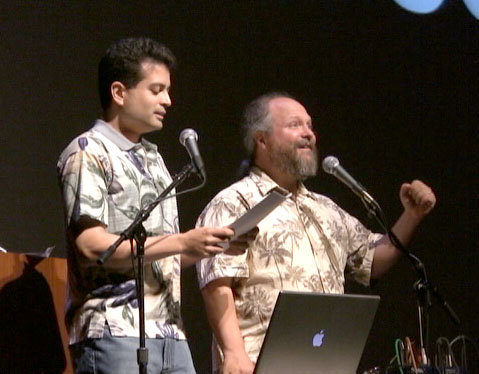
Welcome to the 2009 Worm Show page!
2005 Worm Show Page / 2007 Worm Show Page
Curtis and Morris had a blast with the 2009 Worm Show (June 27, 2009) at the International C. elegans Meeting at UCLA. It is available on YouTube here. The show almost didn't happen. Below is an explanation for how we managed to pull the show together, plus information about the DVD, some technical information, and some insight into the different bits. - M. Maduro & C. Loer
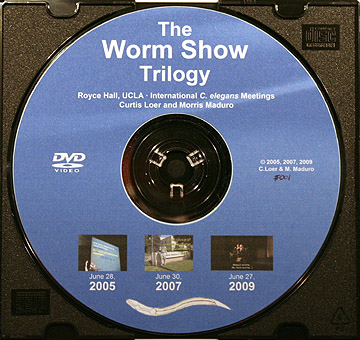
A DVD with the 2005, 2007 and 2009 shows is now available!
We are proud to present The Worm Show Trilogy, a DVD with the 2005, 2007 and 2009 shows on it - a total of over 2 hours and 15 minutes of entertainment! This version features the 2005 and 2007 shows in their original 4:3 aspect ratio, and the 2009 show in 16:9 widescreen. And for the first time, each show has a submenu with chapter/access points. Now that the shows are available on YouTube (see here), we don't expect a demand for these any more. But if you would still like a DVD, email Morris (mmaduro@ucr.edu).
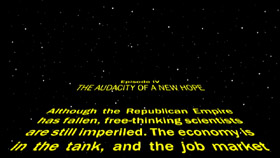
the Star Wars text crawl, for the 3rd time |
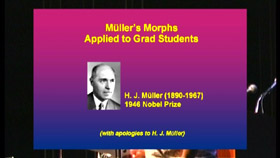 Muller's Morphs
Muller's Morphs |
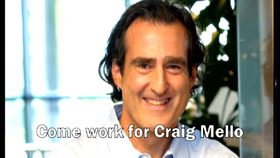 a lab advertisement
a lab advertisement |
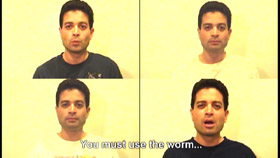 You Must Use The Worm...
You Must Use The Worm... |
 a Talk Not Selected
a Talk Not Selected |
 An apocryphal Great Moment in Worm History
An apocryphal Great Moment in Worm History |
 "Wormy Got Back"
"Wormy Got Back" |
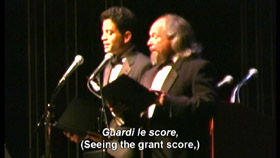 Nessun Worma
Nessun Worma |
 |
What was the big technical problem before the show?
The show, like the three preceding it, was built as a series of Powerpoint 2003 presentations launched from links within a central Powerpoint file. [For the geeks reading this, movies were mpg-1 of 2048 kbit/sec bitrate, 29.97-30fps and varying sizes (448x336 or 640x480)]. The computer was intended to be Morris' venerable 2002 Sony Vaio, running WinXP Home with a scant single 1.13 GHz processor and a paltry 256 MB of RAM. Its onboard video card had no prior problems with a 1024x768 external monitor, which is what we did in 2004 (Santa Barbara), 2005 and 2007 (Royce Hall, UCLA). However, in 2009 the dataprojector used in Royce has been updated, and seemed to require a minimum resolution of 1400 pixels horizontal. This caused the Vaio to choke and it could only run the mpg videos at a choppy 3-5 fps! Morris tried his backup Asus Aspire Netbook, but it couldn't output to the system at all (a problem they had previously encountered). Now in a panic, we tried to find someone with a PC laptop on hand. They had none at Royce Hall, but someone who was just outside waiting to get in did loan us a Windows Vista machine. They had no power supply (meaning that the show could've quit mid-way) but we arranged for them to get driven to the dorm to get it. Sadly, however, they had OpenOffice, and not MS Powerpoint, and it did not work with the links/files in the show. Our only option then became a Macintosh laptop that they had available for the talks. By the time the other PC had become available, Morris had already loaded the show content folder onto the Mac, but was shocked to find that none of the links to the other Powerpoint presentations worked even though they were in the same folder. He hurriedly reassigned them, and in testing found that when they were clicked, a security warning came up. This could not be disabled (and Morris does not even know if this is possible) though it looked like all the media files ran; thankfully mpg-1 is such an old format that it could be played, albeit still slightly choppily on the Mac. The whole drama took about half an hour to play out, which delayed letting people in to Royce Hall, and delayed the show starting, but thankfully there was only one real glitch after that (see the next section below). The stagehands at Royce Hall were remarkably calm and supportive during this time, and we owe them a lot for helping keep our wits about us.
This all means, of course, that we owe the success of the 2009 show to the Macintosh! 
 |
What happened at the very end?
If you saw the show live, during our 'Nessun Worma' finale the orchestra accompaniment cut out in the last several measures. Arrgh! Why did this happen? The audio file (an mp3 file) was inserted in the first slide and instructed to run for some 15 slides unattended, well enough to accomodate those that would have run automatically if the presentation had been on the PC laptop. The problem was, running on the Mac, the timing of slide advancement changed, so the words were coming up at the wrong time. During the show, I moved the slides back or forward as needed to (try to) keep them in sync with what we were singing. Each navigation added +1 to the total number of slides - and when that total reached 15, the song stopped. So the stopping of the music was a direct result of having changed machines and my own shortsightedness in not setting the slide total to something much higher (like 50). Well, the show must (and did) go on. For the DVD and video, the missing music has been restored to its full glory. [Nessun Dorma ends with a huge crescendo, after all! If you have never heard the late Luciano Pavarotti sing what became his signature aria, check this out.] Let us never speak of this glitch again!

|
How was Nessun Dorma edited?
The original has another verse and (if it's performed as in the opera Turandot) there is a choir part in the middle. Starting with a karaoke orchestration, we deleted the intervening verse to shorten the piece, and as it would have been impossible to change the words that the choir was singing anyways. We also increased the tempo slightly and lowered the pitch by four semitones. While all other musical parodies we have done were sung in their original keys, that high B is a killer, especially live, but a high G is okay. [Even Pavarotti's last appearance was a playback performance pitched down to a high A. But Pavarotti was ill, he was 71 years old, and it was freezing outside.]
Curtis actually happened to find online (somewhat at random) an arrangement of Nessun Dorma including the voice (“Voce”) part transposed just as we performed it. For fun he altered the music further to include the lyrics and music just as it was ultimately performed (found below). The lyrics are a mix of real and fake Italian (and maybe you noticed the Yiddish, too), generally grammatically butchered even where the Italian is real. (We love the Italian language, but aren’t particularly adept with it. Curtis wishes to apologize personally to his old friend Massimo H. for the ‘Italiano molto bruto.’)
Our favorite part of the lyrics is “Il stronzo mangia mozzarella” which translates literally as “The sh-t eats mozzarella” [That’s ‘sh-t’ as in jerk/schmuck/a--hole.] This is imagined as an angry and powerful insult to the reviewer of ‘la granta’ that gave it a ‘piccolo’ [small] and hence ‘tragico’ score. Later, after the totally fake ‘resubmite,’ the use of ‘in tempo’ translated as ‘in time’ in the context is not a correct usage, but is an intentional play on words since it really does mean ‘in tempo’ as in having the correct musical time/tempo (and ‘tempo’ is more likely to be understood in English to mean ‘time.’) [Is it bad to explain all the jokes?]
The final version of the lyrics were completed less than 24 hrs before the show during the meeting. Curtis was apparently in a parallel session of his own making...
"Nessun Worma" sheet music - the ‘arranged by’ [arrangiamento di] credit is from the original sheet music. The ‘mutilated by’ [mutilato di] credit is added.

|
What are the source/original videos for the 'Found on YouTube' parodies?
Lightcycler 480, epMotion, The PCR Song, G-T-C-A, Leave Britney Alone, Rick Astley (RickRolled), John Williams Is The Man.
The "John Williams is the Man" parody was especially challenging. This choral piece was produced by the group Moosebutter and their recording was used by Corey Vidal for his video. The sheet music was available on the Internet at the time, and Morris had to record each part separately (of course). The most effective way was to learn each part, then sing along with Corey Vidal's video to keep the timing. Hence, Morris' version is in the same key and tempo as the original. By using headphones to listen to the original, the sound would not be picked up by the microphone used for the new recording. One challenge was whistling for the very first part. In fact, the second occurrence of the whistling was just the first one, repeated, because it was the only good take. The individual voice recordings were then mixed in CoolEdit 2000 Pro - you may notice that each voice occupies a slightly different position in the stereo image. After that, four videos were shot and edited together to give the final product. The whole thing (and it's only the first part of the song) took an evening. There are a few mistakes, such as words being sung that are not 'mouthed' by one of the heads. It is difficult to see, but Morris is wearing a scientific meeting shirt in each of the four small videos - one is from the Madison meeting in 1999, one is from the West Coast meeting in Santa Barbara 2004, one is from SDB 2005, and one is from one of the Embryology Course offerings at Woods Hole, MA.
How was the "Chippendale's" video made?
The Chippendale's video was made using JibJab.com.
More trivia, technical information, and fun facts:
-
First Worm Show with a prologue; without an 'Acknowledgments' gag; for Owen Lewis to not introduce Curtis & Morris (Curtis did this for '09); first show shot in 16:9 widescreen (and high definition for one camera, though the high-def footage was downsampled for editing); with both performers having tenure (hence, 'I due tenure' in the last part); with only one Top 10 list (the others had two each); with a Democrat in the White House.
-
Second Worm Show to show Sydney Brenner before the Star Wars intro.
-
Third Worm Show to start with the Star Wars theme and text crawl, and also end with Star Wars music. Just before the show, Judith Yanowitz suggested to us that the color of the text should be green in honor of GFP and Marty Chalfie, but it was too late to re-render it all. (Trivia: The text crawl took about two hours to render completely, using Animation:Master 8.0.)
-
The subtitle 'Episode IV: The Audacity of A New Hope' is obviously a combination of the subtitle for Star Wars Episode IV (A New Hope) and the title of Barack Obama's book, The Audacity of Hope.
-
Why is it called a Trilogy when the 2009 show is Episode IV? The first episode was performed at the 2004 West Coast Meeting in Santa Barbara. As noted on the page for the prior DVD, much of the 2004 show was incorporated into the 2005 show. We introduced the 'Star Wars' theme to the 2005 show and it made sense to call it Episode II because it did have new material. So the Trilogy comprises Episodes II, III and IV.
-
How are YouTube videos saved and used? On a PC, the simple program VideoCacheView allows the retrieval of videos viewed on YouTube (and other pages) to be downloaded right out of the temporary items folder. These are usually saved as .flv (Flash Video) files. To get them into a form that could be used by other programs, Super was used to re-encode them as AVI files using the DV codec. [For some reason, not all .flv files could be read by Super.] For audio-only extraction, there is an audio record feature built into the GOM player (this was used to get the accompaniments for 'Mellow Yellow' and 'Baby Got Back'). The GOM player can play back .flv files directly. As of June, 2009, all of these programs were available for free. [In 2007, videos were captured by outputting to a VGA-to-NTSC converter, then by recording to a DV camcorder. This worked but was far from ideal and produced videos with strange mid-frame sync problems. You can see this, for example, in the U2 video to 'Vertigo' used in the 2007 show.]
-
In the 2005 show, there was alcohol served with the dinner beforehand, so we thought it would be the same in 2007. We were wrong, and when we discovered this at the barbecue (minutes before showtime) it was too late to remove the 'The Audience Is Intoxicated' THX intro parody. For 2009, the text crawl contains the text 'You have been drinking this time, right?' [note the 'have' is actually in italics in the crawl but this is almost imperceptible]. Just in case Curtis and Morris' plea with the meeting organizers did not work, a version of the introductory video that lacked these last few lines was pre-rendered and available to use for the show. Thankfully, the drinks were back for 2009!
-
Each of the 2005, 2007 and 2009 shows contains internal Star Wars references. In 2005, this was the Yoda Talk; in 2007, it was the Chewbacca Talk; and in 2009, it was the 'You Must Use The Worm' parody: The original Moosebutter song ("John Williams Is The Man") is all about Star Wars.
-
For the 'In The Lab' parody of Gary Numan's song "Cars" Morris wore white face makeup and eyeliner to reproduce Gary Numan's look in that video (and others like this). Maybe it was a bit much. To copy the sound that Numan uses, the vocal track was doubled and added back to the soundtrack a split-second later.
-
The Worm Show could be considered to be a 'dominant-negative' (really, just an inhibitor) if it is played in the lab and inhibits at least one person from getting real work done.
-
The 'Wormy Got Back' parody used a backing track from a YouTube file similar to this one. You can hear the scratches/pops from the original record in the Worm Show itself. The song was edited down so it was only about 2.5 minutes long. The original artist, Sir Mix-A-Lot, appears a few times in the video.
-
The program used for editing the video was Sony Vegas Platinum 8.0. (See a screenshot of the work-in-progress here.) Morris' now-dated home PC could not handle rendering the video effects combined with encoding the required 720x480 mpeg2 file required for making a DVD - it would lock up or throw an exception. Conquently, the 49-minute show had to be rendered first to near-lossless AVI (YUV) compression in two-minute pieces (which also produced the occasional lock-up), then the 25 pieces had to be assembled in a new Vegas file. Those could then be rendered to mpeg2. All told, preparation of the DVD consumed some 200 GB of hard drive space. During mpeg2 renders, and during DVD-R burning, a large fan was blown into the computer case to make sure the computer did not overheat (see a picture here).
-
The DVD was mastered using Sony DVD Architect 4.5. This amazing program permits assembly of slick DVDs. In particular we were able to include chapter points to access specific parts. The previous DVDs had access precisely every five minutes. A 30-second compendium of sound clips from the three shows is the background audio for the main menu.
-
In all Worm Shows, Morris ran the microphones and computer through his own mixer on stage. That way he could control the audio from the laptop, as well as directly record the audio from the mics and computer to a digital recorder. In 2005, this was a camcorder (taking video from the camera taping from the audience); in 2007 and 2009, this was a Roland Edirol R-1 recording at uncompressed 44.1 kHz 16-bit to a CompactFlash memory card. In 2005 and 2007 the digital recordings were started late (Morris' mistake). At the 2009 show the audio file was started very early, but the whole thing was almost lost: One of the stagehands unplugged everything on stage as part of the teardown, while the Edirol was still recording. The resultant 500-MB file was corrupted and wouldn't open, but MM managed to access it in CoolEdit 2000 after doing a 'file restore' in Windows XP.
-
The footage from the 1995 International C. elegans Meeting was originally shot on an analog Sony 8mm camcorder. Analog footage is interlaced, and the field order is critical to keeping it looking smooth. Digital video is progressive. During transfer to digital, however, the field order was not consistent, so the resultant clips on the DVD have some odd 'flicker' to them in parts with a lot of motion, especially when viewed on a television. This is exacerbated by the fact that the video was resized for 16:9 by cropping. The effect is not so visible when viewed on a computer. As it produces only a minimal disruption of the Worm Show viewing experience, it was not deemed worthwhile to try to fix the problem another way and re-encode the whole show.
-
Three cameras were used to capture the footage. One was the camera used in Royce Hall itself to produce the stage monitor images that can be seen as a person enters the theater - Morris tapped into the signal backstage (as with the 2007 show). Since 2007 a better camera was installed. To incorporate footage into the DVD, the image was cropped to a 16:9 aspect ratio. The second camera was run by Melissa Owraghi and was a Canon HV30 high-definition HDV camera capturing in 1440x1080i, downsized to 720x480 for editing to make the DVD. The third camera was a Canon GL1 operated by Gina Broitman-Maduro, capturing in DV, 720x480, in widescreen 16:9 mode. The audio from the stage mixer was itself combined with audio from the GL1 to get the sound of the audience. The sound quality from the GL1's stereo microphone was very bright and clear compared to what was used previously.
-
In order to fit all three Worm Shows on a single-layer DVD-R, the 2005 and 2007 shows were re-compressed to an average bitrate of 2800 kbit/sec. As the shows do not have a lot of motion, the resultant loss in quality is not that noticeable.
-
Samson Q7 microphones were used for voice recording in audio/movie clips used during the show, passed through a Yamaha MG82CX mixer with built-in effects processor. For 2007, a similar Yamaha MG10/2 mixer was used with an Alesis Picoverb processor. The same Yamaha MG10/2 mixer was used live on stage during the 2005, 2007 and 2009 shows.
-
A small editing glitch is visible a few times in the first few minutes of the show. A view from another camera is just barely perceptible in a few spots early in the show, e.g. right before the 'MacBook AIR-2' and 'Madoff' slides. This resulted from a mistake in the way the camera views were alternated in editing: A horizontal bar that indicates how much each camera view contributes was not quite at 0% or 100%. It is such a minor glitch that it will be left in.
-
The 2009 show is in 16:9, so the video should fill the entire screen if you have a 16:9 television. If it does not, you probably have your DVD player set to output to a 4:3 television (see image on bottom right, below). You can change this in the DVD player's system menu. Many people have had a 16:9 television for years, but their DVD player has been further 'squishing' their movies because it thinks it is sending video to a 4:3 television. Even in some stores demonstrating TVs, this is improperly set! The inverse problem can happen if a DVD player is connected to a 4:3 set but is set to 16:9 (not shown). Of course, if you are happy viewing the shows stretched or squished, go for it. If you are using an HDMI cable to connect to your TV, the 2005 and 2007 shows will be stretched out to a 16:9 aspect ratio. Some DVD players and/or TVs will not allow you to undo this effect; you might have to connect your DVD player to your 16:9 TV another way (e.g. component or S-video).
 2007 Show
2007 Show
on 4:3 television
(correct) |
|
 2007 Show
2007 Show
on 16:9 television
(stretched, wrong aspect) |
|

2009 Show
on 16:9 television
(correct) |

2009 Show
on 16:9 television
(squished, wrong aspect) |
-
For the 2009 show on the DVD, many of the embedded videos were re-edited for a 16:9 ratio. Some, like the Chippendale's video, were left as 4:3 because of too much image distortion or because there would be too much information lost by cropping. When viewed on a 4:3 television, this results in windowboxing. (This is a common effect seen today when a 4:3 commercial runs on a 16:9 broadcast viewed on a 4:3 television, you get letterboxing and pillarboxing.)
-
The DVD has a label affixed to the front surface. It is possible that the extra weight, especially if it is slightly off-center, could compromise proper playback. As the labels are applied with a centering device, it is not likely to be an issue, and it has not been an issue with these labels in the past. Hence, you should assume that it will work on your setup. Even if you think the label is a problem, do not try to peel off the sticker! It may destroy the disc. Instead, copy the DVD to a single-layer DVD-R. During the copying process, the DVD drive that is reading will slow down the rpm to read the disc.
-
For the 2005 and 2007 shows, extra attention had to be paid to the 'TV safe' area. Images on older television tubes were cropped considerably by the frame of the TV. For the 2009 video this was less critical for two reasons. First, 16:9 televisions have almost no overscan, and second, on a conventional TV, DVD players will letterbox the output so the top and bottom have zero overscan (some occurs on the left/right though).
-
For some reason, a few videos have a bit of unused image on the sides (e.g. see the colorful still image in the table above that says 'Your undergrad degree is through'). Oh well.
-
The DVD is missing some acknowledgements for original songs: "Mellow Yellow" by Donovan; "Light My Fire" by the Doors; and "Maria" from West Side Story by Leonard Bernstein and Stephen Sondheim.
-
During summer of 2012, the YouTube video of the 2009 show got blocked worldwide because the copyright content filter detected the "Chippendale's" bit. Although we paid for this video from JibJab, apparently some other place has marked a similar parody as copyrighted. In order to restore the whole video, that portion of the show was overdubbed with a beat-matched different piece of music (Jean-Michel Jarre's "La Cage (Vitalic Remix)"), and the video had to be zoomed in slightly.
-
A lot more trivia about the 2005/2007 shows appears on the 2007 DVD page.

download the 'bad Powerpoint background'

|
Really now, get back to work.
|
More information:
Worm Show Page
2005 Worm Show / 2007 Worm Show / 2011 Worm Show
last updated 06-16-2012
Home | News | Research | People | Papers
Pictures | Resources | Contact

|